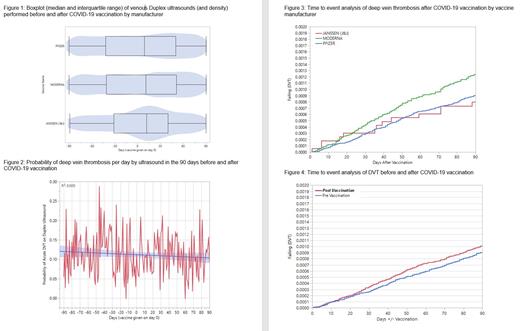Abstract

Background: COVID-19 vaccinations in the United States (Janssen, Moderna, and Pfizer) have been deemed generally safe and effective. Rare thrombotic events, now termed vaccine-induced thrombotic thrombocytopenia (VITT), have been reported after the Janssen and Moderna vaccinations. With millions of vaccinations being administered to adults, it is expected that some deep vein thrombosis (DVT) will occur coincidentally with vaccination. Whether COVID-19 vaccinations may contribute to DVT risk more generally (outside of VITT) has not been well studied outside of the initial clinical trials.
Aims: Evaluate trends in DVT diagnosis before and after COVID-19 vaccination
Methods: Vaccinated patients ≥ 18 years between 11/6/2020 through 6/1/2021 were analyzed using electronic medical records across the Mayo Clinic enterprise. Upper and lower DVT venous Duplex ultrasound (DUS) reports occurring 90 days before and after vaccination date (first dose for Pfizer and Moderna vaccines) were extracted and analyzed with a highly accurate, previously validated, Natural Language Processing (NLP) algorithm for acute DVT.
Results: 382,527 patients with at least 1 COVID-19 vaccination were identified. The median age was 61 (IQR 44-72) and 55.3% were male. Pfizer was the most common vaccine administered (n=245,572, 64.2%), followed by Moderna (n=120,683, 31.6%) and Janssen (n=16,272, 4.3%). Most patients (91.5%) receiving vaccinations were from states with Mayo Clinic health services (Minnesota, n=197,834; Wisconsin, n=80,720; Florida, n=42,391; Arizona, n=28,882). The mean age at vaccination was 61.0 (SD 17.7), 56.5 (SD 19.1), and 54.7 (SD 16.3) for Moderna, Pfizer, and Janssen vaccines respectively. Women were most likely to receive the Pfizer (56.3%) compared to Moderna (54.1%) and Janssen (49.5%) vaccines. Non-white patients were most likely to receive Janssen (21%) compared to Moderna (7.7%) and Pfizer (8.2%) vaccines. Among all patients, 7,265 upper and lower venous DUS were performed in 5,960 patients. Figure 1 shows the utilization of DUS before and after COVID-19 vaccination and shows that more patients underwent DUS in the 90 days after vaccination compared to 90 days pre-vaccination. Acute DVT was identified by the NLP algorithm in 808 (714 patients) ultrasounds (11.1%); 656 out of 6136 lower extremity DUS (10.7%) and 152 out of 1129 upper extremity DUS (13.5%). The overall rate of acute DVT (upper and lower) was 1.86 per 1000 patients, consistent with the expected background epidemiologic rate. Figure 2 shows the daily probability of acute DVT by ultrasound report in the 90 days before and after vaccination with a linear regression best fit line showing no overall correlation (R 2 = 0.0). Overall acute DVT post-vaccination occurred on 10.8% of DUS compared to 11.6% pre-vaccination (p=0.28). Among ultrasound reports in Janssen vaccinated patients, 7.0% of post-vaccination compared to 18.0% of pre-vaccination were positive for acute DVT (p=0.003). Among ultrasound reports in Moderna vaccinated patients, 11.0% of post-vaccination compared to 12.7% of pre-vaccination were positive for acute DVT (p=0.15). Among ultrasound reports in Pfizer vaccinated patients, 11.0% of post-vaccination compared to 10.4% of pre-vaccination were positive for acute DVT (p=0.56). Using a Cox proportional hazard model, pre vs post-vaccination time among the same patient cohort was compared for each vaccine. The hazard ratio for DVT post-vaccination was 0.68 (95% CI 0.34-1.38) for Janssen, 1.08 (95% CI 0.86-1.35) for Moderna, and 1.20 (95% CI 0.99-1.46) for Pfizer. After adjusting for age and sex, Pfizer and Janssen's vaccines did not have different risks for DVT compared to Moderna in the 90 days post-vaccination (HR 0.80, 95% CI 0.98-1.25 and HR 0.75, 95% CI 0.42-1.32 respectively).
Conclusions: In this large cohort of COVID-19 vaccinated patients, no increased risk for acute DVT post-vaccination was identified for any of the approved vaccinations in the United States. Additionally, no significant difference was seen in the risk for DVT post-vaccination when comparing each vaccine to each other. The probability of acute DVT on ultrasounds in the 90 days post-vaccination was lower than the pre-vaccination period with the Janssen vaccine possibly indicating over-testing in this group. These results provide additional reassurance of the safety of approved COVID-19 vaccines.
Padmanabhan: Veralox Therapeutics: Membership on an entity's Board of Directors or advisory committees. Pruthi: HEMA Biologics: Honoraria; CSL Behring: Honoraria; Genentech: Honoraria; Instrumentation Laboratory: Honoraria; Bayer Healthcare AG: Honoraria; Merck: Honoraria.
Author notes
 This icon denotes a clinically relevant abstract
This icon denotes a clinically relevant abstract


This feature is available to Subscribers Only
Sign In or Create an Account Close Modal